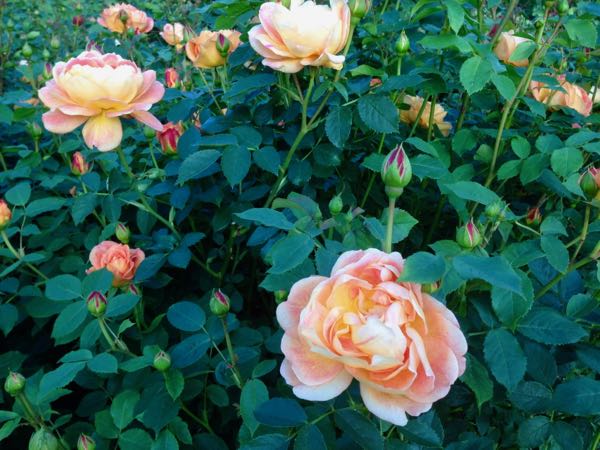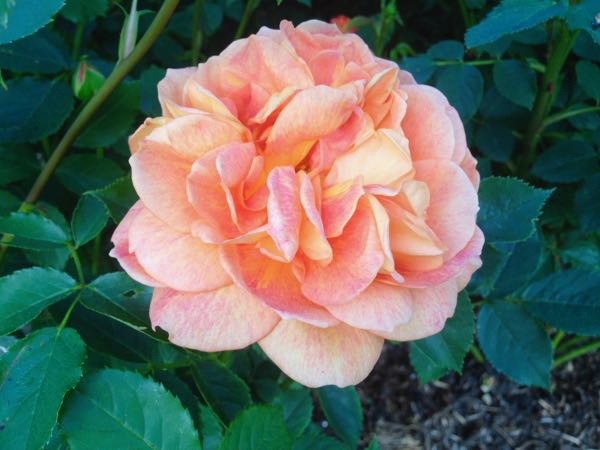Rosa ‘Lady of Shalott’ is a captivating English shrub rose renowned for its beauty and charm. Bred by the esteemed David Austin and introduced in 2009, this rose variety belongs to the Rosaceae family of plants. Its name pays homage to the beloved ballad penned by Alfred Lord Tennyson, a renowned 19th-century poet. With its remarkable attributes and enchanting blooms, Rosa ‘Lady of Shalott’ has quickly become a cherished addition to gardens around the world.
The flowers of Rosa ‘Lady of Shalott’ are truly a sight to behold. Adorned with a captivating blend of salmon-pink and light orange hues, each petal reveals a subtle yellow underside, adding depth and intrigue to the blossoms. The chalice-shaped flowers showcase a delicate form and exude a gentle fragrance, enticing both the eyes and the nose. These exquisite blooms grace the landscape with their elegance and create an atmosphere of enchantment.
Rosa ‘Lady of Shalott’ is a robust shrub rose that can reach a height of 5 feet or 1.5 meters, creating an impressive presence in the garden. Its vigorous growth habit, combined with its ability to produce abundant blooms, makes it a standout performer. This rose variety is renowned for its repeat flowering nature, delighting gardeners with a continuous display of blossoms from late spring to the end of autumn. With each passing season, Rosa ‘Lady of Shalott’ showcases its enduring beauty and unfading allure.

How to Grow Rosa ‘Lady of Shalott’:
To ensure the successful growth and abundant flowering of Rosa ‘Lady of Shalott,’ consider the following care guidelines:
1. Sun and Soil Requirements: Plant Rosa ‘Lady of Shalott’ in a location that receives ample sunlight, ideally in full sun or partial shade. Provide it with well-drained soil that is rich in organic matter. A fertile and moist soil environment will promote healthy growth and vibrant blooms.
2. Disease Resistance and Pest Management: Rosa ‘Lady of Shalott’ boasts excellent disease resistance, making it a reliable choice for gardeners. However, it is still important to monitor the plant for any signs of common rose diseases, such as blackspot and powdery mildew. Regular inspection and prompt removal of any affected foliage can help prevent the spread of disease. Additionally, be on the lookout for pests, particularly aphids and spider mites. Employ appropriate pest control measures if necessary, ensuring the health and vitality of the plant.
3. Pruning and Maintenance: Prune Rosa ‘Lady of Shalott’ in early spring to remove any dead, damaged, or crossing branches. This promotes better airflow and encourages new growth and abundant flowering. Regularly remove spent flowers to stimulate further blooming and maintain the plant’s neat appearance.
4. Fertilization and Watering: Provide regular watering to keep the soil evenly moist, especially during dry periods. Apply a balanced rose fertilizer in early spring and again after the first flush of blooms to provide essential nutrients for healthy growth and continuous flowering.
With its exquisite blooms, repeat flowering habit, and overall resilience, Rosa ‘Lady of Shalott’ graces gardens with a touch of elegance and romantic allure. Whether planted as a focal point in a flowerbed, mixed with other shrubs and perennials, or trained against a trellis or wall, this English rose variety captivates the senses and brings enduring beauty to outdoor spaces. Embrace the charm of Rosa ‘Lady of Shalott’ and let its splendor flourish in your garden, creating a haven of serenity and grace.




